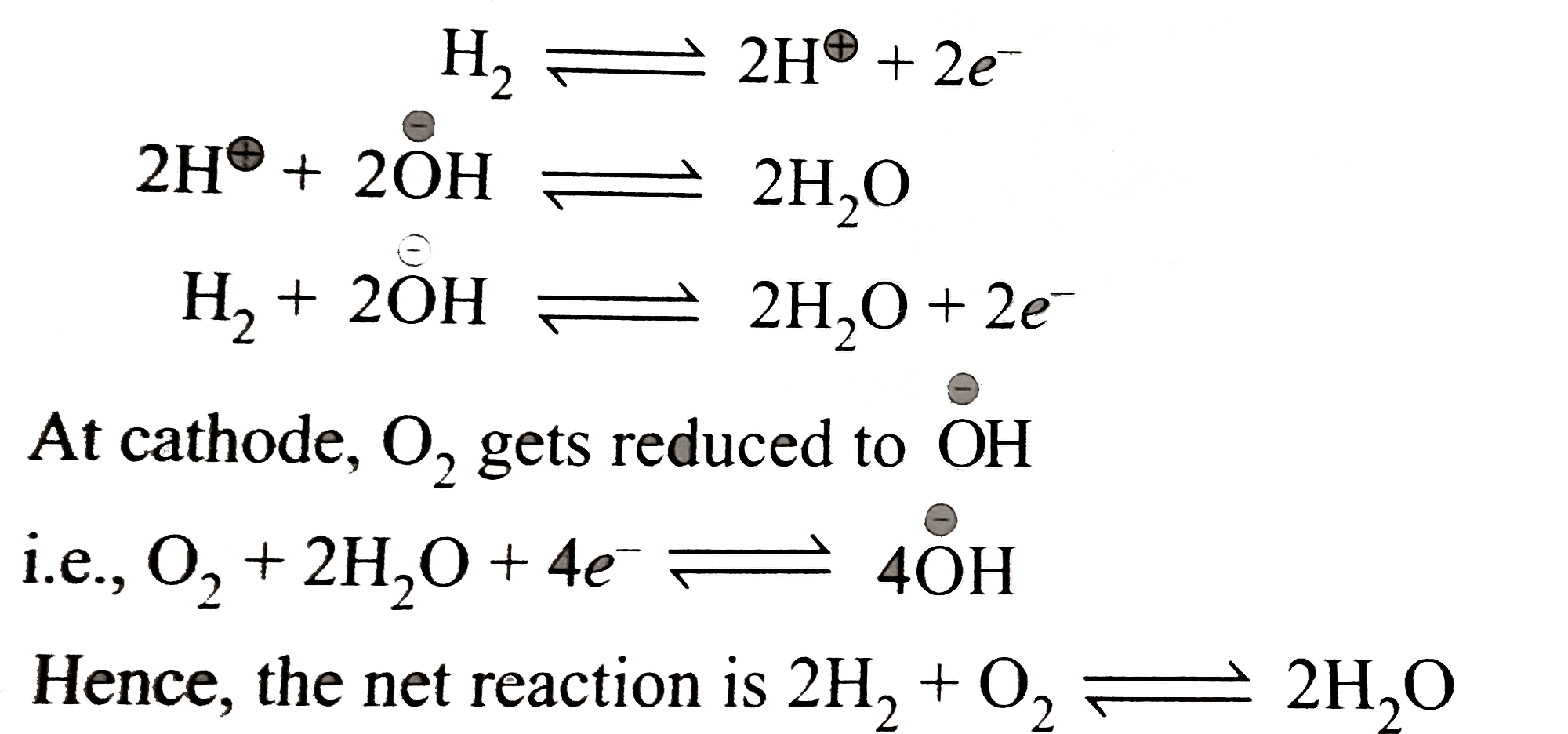The overall reactions of a hydrogen -oxygen fuel cell is
2H2(g)+O2(g)→2H2O(l)
2H2(g)+4OH(aq)→4H2O(l)+4e−
O2(g)+2H2O(l)+4e−→4OH−(aq)
4OH−(aq)+4e−→2H2O(l)
The correct Answer is:A
At anode:2H2(g)+4OH−(aq)→4H2O(l)+4e−At cathode:O2(g)+2H2O(l)+4e−→4OH(aq)Overall reaction:2H2(g)+O2(g)→2H2O(l)
Topper's Solved these Questions
- ELECTROCHEMISTRYBook:NCERT FINGERTIPSChapter:ELECTROCHEMISTRYExercise:Corrosion
Explore 1 Video
- ELECTROCHEMISTRYBook:NCERT FINGERTIPSChapter:ELECTROCHEMISTRYExercise:Higher Order Thinking Skills
Explore 9 Videos
- ELECTROCHEMISTRYBook:NCERT FINGERTIPSChapter:ELECTROCHEMISTRYExercise:Batteries
Explore 2 Videos
- COORDINATION COMPOUNDS Book:NCERT FINGERTIPSChapter:COORDINATION COMPOUNDS Exercise:Assertion And Reason
Explore 15 Videos
- GENERAL PRINCIPLES AND PROCESSES OF ISOLATION OF ELEMENTSBook:NCERT FINGERTIPSChapter:GENERAL PRINCIPLES AND PROCESSES OF ISOLATION OF ELEMENTSExercise:Assertion And Reason
Explore 15 Videos
Similar Questions
Knowledge Check
A fuel cell is
Athe voltaic cells in which discontinuous supply of fuels are send at anode to give oxidationBthe voltaic cell in which fuels such as : CH4,H2,CO are used up at anodeCit involves the reactions of H2−O2 fuel cell such as
Cathode : 2H2+4OH−→4H2O(l)+4e
Anode : O2+2H2O(l)+4e→4OH−Dthe efficiency of a H2−O2 fuel cell is very lowPurpose of hydrogen -oxygen fuel cell is to
AGenerate heatBCcreate potential differenceCProduce high purity waterDRemove adsorbed oxygen from electrode surfaceThe effciency of the hydrogen-oxygen fuel cell is about
A0.2B0.4C0.7D0.9
Fuel cells : Fuel cells are galvanic cells in which the chemical energy of fuel cell is directly converted into electrical energy. A type of fuel cell is a hydrogen − oxygen fuel cell. It consists of two electrodes made up of two porous graphite impregnated with a catalyst ( platinum, silver, or metal oxide ). The electrodes are placed in aqueous solution of NaOH . Oxygen and hydrogen are continuously fed into the cell. Hydrogen gets oxidized to H⊕ which is neutralized by c−OH,i.e., anodic reaction.

At cathode, O2 gets reduced to c−OH

Hence, the net reaction is
The overall reaction has
ΔH=−285.6kJmol−1 and ΔG=−237.4kJmol−1 at 25∘C
If the cell voltage is 1.23V for the H2−O2 fuel cell and for the half cell :
View SolutionFuel cells : Fuel cells are galvanic cells in which the chemical energy of fuel cell is directly converted into electrical energy. A type of fuel cell is a hydrogen − oxygen fuel cell. It consists of two electrodes made up of two porous graphite impregnated with a catalyst ( platinum, silver, or metal oxide ). The electrodes are placed in aqueous solution of NaOH . Oxygen and hydrogen are continuously fed into the cell. Hydrogen gets oxidized to H⊕ which is neutralized by c−OH,i.e., anodic reaction.

At cathode, O2 gets reduced to c−OH
Hence, the net reaction is
The overall reaction has
ΔH=−285.6kJmol−1 and ΔG=−237.4kJmol−1 at 25∘C
What is the value of ΔSc− for the fuel cell at 25∘C?
View SolutionFuel cells : Fuel cells are galvanic cells in which the chemical energy of fuel cell is directly converted into electrical energy. A type of fuel cell is a hydrogen − oxygen fuel cell. It consists of two electrodes made up of two porous graphite impregnated with a catalyst ( platinum, silver, or metal oxide ). The electrodes are placed in aqueous solution of NaOH . Oxygen and hydrogen are continuously fed into the cell. Hydrogen gets oxidized to H⊕ which is neutralized by c−OH,i.e., anodic reaction.

At cathode, O2 gets reduced to c−OH
Hence, the net reaction is
The overall reaction has
ΔH=−285.6kJmol−1 and ΔG=−237.4kJmol−1 at 25∘C
Suppose the concentration of hydroxide ioin in the cell is doubled, then the cell voltage will be
View SolutionFuel cells : Fuel cells are galvanic cells in which the chemical energy of fuel cell is directly converted into electrical energy. A type of fuel cell is a hydrogen − oxygen fuel cell. It consists of two electrodes made up of two porous graphite impregnated with a catalyst ( platinum, silver, or metal oxide ). The electrodes are placed in aqueous solution of NaOH . Oxygen and hydrogen are continuously fed into the cell. Hydrogen gets oxidized to H⊕ which is neutralized by c−OH,i.e., anodic reaction.

At cathode, O2 gets reduced to c−OH
Hence, the net reaction is
The overall reaction has
ΔH=−285.6kJmol−1 and ΔG=−237.4kJmol−1 at 25∘C
A fuel cell is
I. A voltaic cell in which continuous supply of fuels are sent at anode to perform oxidation.
II. A voltaci cell in which fuels such as :CH4,H2, and CO are used up at anode.
III. One which involves the reaction of H2−O2 fuel cell such as :
Anode :2H2O+4c−OH→4H2O(l)+4ec−
Cathode :O2+2H2O(l)=4e−→4c−OH
IV. The efficiency of H2−O20 fuel cell is 70 to 75%
View SolutionWhich of the following is NOT used in hydrogen-oxygen fuel cell ?
View Solution

